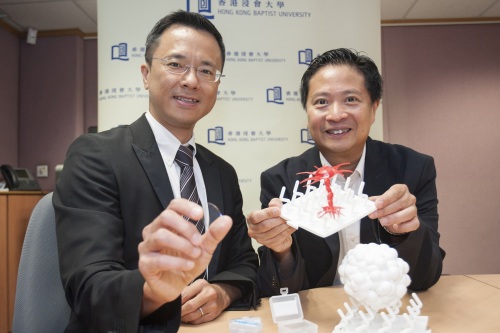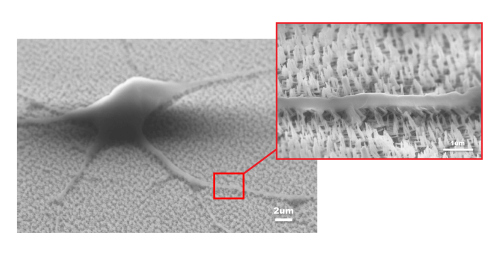|
| Thursday, 21 June 2018, 11:00 HKT/SGT | |
| |  | |
Source: HKBU | |
|
|
|
HONG KONG, June 21, 2018 - (ACN Newswire) - The research team of Hong Kong Baptist University (HKBU) invented a medical device with a specific nanotechnology layer for the proliferation and differentiation of neural stem cells (NSCs) in vitro. Compared with traditional methods, the team's novel matrix can reduce the risk of carcinogenesis or inflammation in stem cell therapy - a treatment that offers hope of a cure for incurable diseases such as neurodegenerative diseases, chronic systemic diseases and degenerative joint diseases. This pioneering invention won the team the Gold Medal with Congratulations of Jury at the 46th International Exhibition of Inventions of Geneva held in Switzerland in April 2018. The application for a US patent has been filed.
 | | Professor Ken Yung (right) and Dr Jeffery Huang (left) jointly invent the award-winning medical device for safe growth of neural stem cells using nanotechnology. Dr Huang is holding a piece of device. |
 | | (Left) A diagram showing neural stem cell differentiation: the neural stem cell placed on the nano-matrix becomes a functional cell; and (right) it shows the structure of the lightning type ("Z" shape) of the nano-matrix. |
The team was jointly led by Professor Ken Yung Kin-lam of the Department of Biology and Associate Professor Dr Jeffery Huang Zhifeng of the Department of Physics.
Professor Ken Yung said, "With the global population aging rapidly, neurodegenerative diseases (such as Alzheimer's disease and Parkinson's disease) are regarded as the main threat and burden to global healthcare. Recently, scientists have turned their focus on cell replacement therapies, including stem cell therapy, which have shown huge promise in treating neurodegenerative diseases. Stem cell therapy is a treatment using stem cells to cultivate new and normal cells, tissues or organs and then transplanted to people to restore physiological function by replacing damaged or dead cells."
"Traditional methods for proliferation and differentiation of NSCs require a large number of additional growth factors in a culture medium, which are kinds of polypeptides and can regulate many aspects of cellular function that may stimulate the growth of cancer cells and increase the risk of developing tumours in vivo after transplantation," Professor Yung added.
Dr Jeffery Huang said that the layer of nanostructure of their new invention is made of biocompatible materials, and avoids the use of additional growth factor or other biochemical for cultivating cells. After growth and cell differentiation, it is hoped that the mature cell can turn into a therapeutic agent for stem cell therapy.
Dr Huang said, "The NSCs are under 'physical massage' when they come into physiological contact with the matrix we developed. Owing to the appropriate design and choice of materials and structure of the matrix, the 'physical massage' resembles the Chinese medicine acupuncture technique which causes the cells to differentiate into functional cells that are in urgent demand in cell replacement therapy to treat neurodegenerative diseases, cancers and tumours. Importantly, the physical massage, which minimises the use of growth factors, should substantially reduce the risk of carcinogenesis in clinical trials."
Professor Ken Yung said, "The novel matrix enables scientists to cultivate NSCs by adopting the usual method, however with the added advantage of organic compounds (like Polylysine and Polyornithine) being excluded from the process, thereby reducing the potential risk of carcinogenesis or inflammation in stem cell therapy. It could provide a safe platform for research into stem cell therapies using the latest, novel nanotechnology, and also help boost the development of regenerative medicine."
Making use of the proprietary invention, the team has established Mat-A-Cell Limited with the aim of providing an advanced device to research institutions and companies that develop cell therapy.
For more details, please refer to: https://www.youtube.com/watch?v=F-Hi-fusocY
Press release distributed by ResearchSEA for Hong Kong Baptist University.
Topic: Press release summary
Source: HKBU
Sectors: Chemicals, Spec.Chem, Science & Nanotech, BioTech, Healthcare & Pharm
https://www.acnnewswire.com
From the Asia Corporate News Network
Copyright © 2024 ACN Newswire. All rights reserved. A division of Asia Corporate News Network.
|
|
|